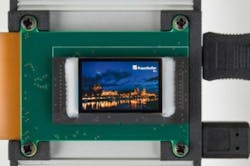Virtual reality (VR) glasses are increasingly popular, but they have usually been heavy and oversized--until now. Large-area organic light-emitting diode (OLED) microdisplays make it possible to produce ergonomic and lightweight VR glasses and reach very high frame rates and high resolutions with "extended full HD". Because OLEDs are self-illuminating, they are energy-efficient and yield very high contrast ratios > 10,000:1. In addition, the fact that there is no need for a backlight means that they can be constructed in a simpler fashion, with fewer optical components. Another advantage is the fast switching speed of OLEDs, which is around a few microseconds compared to milliseconds for LCDs. This enables special modulation processes to improve the perceived image.
RELATED ARTICLE: Thin quantum wells improve brightness and color in microLED microdisplays
As part of the EU's LOMID project--an acronym for large cost-effective OLED microdisplays and their applications--researchers at the Fraunhofer Institute for Organic Electronics, Electron Beam and Plasma Technology (Fraunhofer FEP; Dresden, Germany) have been collaborating with partners from industry to develop innovative OLED microdisplays that significantly outperform others currently on the market. Within LOMID, Fraunhofer FEP is responsible for designing the circuit on the silicon chip, creating OLED prototypes, and coordinating the whole project.
Philipp Wartenberg, head of department at Fraunhofer FEP, says, "Our goal is to develop a new generation of OLED displays that provide outstanding picture quality and make it possible to produce VR glasses in a compact format. We aim to achieve that by means of a specially designed OLED microdisplay." The microdisplays achieve extended full HD, which means they have a resolution of 1920 x 1200 pixels (WUXGA). The diagonal screen size is about one inch, and the frame rate is around 120 Hz.
The researchers have already made their first prototype, which they will be presenting in Brussels from December 5 to 7 at the European Forum for Electronic Components and Systems 2017 (EFECS). Further prototypes are due to follow by the middle of 2018. Industry partners involved in the project have already indicated their interest in converting this microdisplay into a marketable product in the near future. In this respect, the use of OLED microdisplays is by no means limited only to VR glasses--even though this may well be the largest market in the medium-term. OLED microdisplays are also suitable for other products such as augmented reality (AR) glasses or view finders in cameras. The underlying technology of CMOS-integrated light emitters (and any detectors) also has potential uses in other market segments such as optical metrology and identification, or optogenetics.
Especially with regard to microdisplays in consumer-facing augmented reality glasses, the researchers still see some as yet unresolved challenges that they wish to tackle in the future. These challenges include: very high levels of luminance and efficiency (which will necessitate removing the color filters used until now, and replacing these with directly structured emitters); a high yield for a large (chip) area; curved surfaces for more compact optics; circular light panels; irregular pixel matrices at even higher pixel density; integrated eye tracking; and transparent substrates.
SOURCE: Fraunhofer FEP; https://www.fep.fraunhofer.de/en/press_media/23_2017.html?utm_campaign=pm1723en

Gail Overton | Senior Editor (2004-2020)
Gail has more than 30 years of engineering, marketing, product management, and editorial experience in the photonics and optical communications industry. Before joining the staff at Laser Focus World in 2004, she held many product management and product marketing roles in the fiber-optics industry, most notably at Hughes (El Segundo, CA), GTE Labs (Waltham, MA), Corning (Corning, NY), Photon Kinetics (Beaverton, OR), and Newport Corporation (Irvine, CA). During her marketing career, Gail published articles in WDM Solutions and Sensors magazine and traveled internationally to conduct product and sales training. Gail received her BS degree in physics, with an emphasis in optics, from San Diego State University in San Diego, CA in May 1986.
